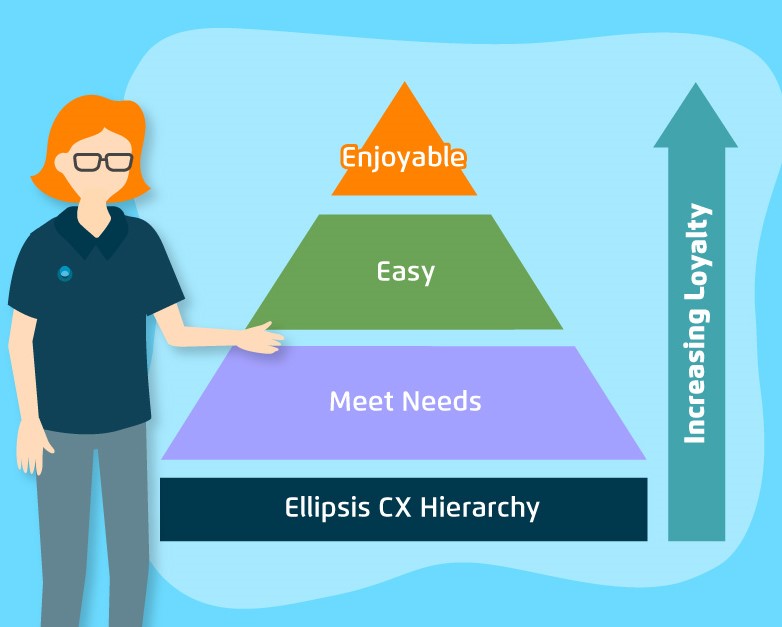
Tired of reading dry, fact-packed articles that are no fun?
Here at Ellipsis, we understand that stories are the most effective way to learn. That’s why we’ve created ‘Sue-Chef: A recipe for customer success’ – a four-part story that follows the fictional example of a meal-kit delivery service that has found its competitive edge (and as a result its customer loyalty) waning. The story follows a cast of fictional characters as they seek to solve the issue and return to a strategy that delights their customers and creates true customer loyalty. We share a summary of highlights from the series...
In the first instalment, we are introduced to Sue-Chef founder Sue, who back in 2015 served a real market need with her meal-kit delivery service for busy lives, which had record-breaking customer acquisition numbers during the first two years of operations. Since then, however, the market has become saturated with competitors – and Sue-Chef has found customer churn growing to unmanageable levels. Sue and the team decide to bring in Elsi, a Customer Strategy Consultant, to help.
Elsi and the team discuss the issues and get to the heart of the matter – the issue is not customer acquisition, but keeping those customers loyal beyond the expiration of any introductory offers. The team discuss the different ways competitive advantage can be reached, deciding that in the beginning, Sue-Chef had competitive advantage through product differentiation, however they no longer have this as new competitors have come onto the scene.

The spectrum of competitive advantage
In instalment two, Elsi and the Sue-Chef team discuss the spectrum of competitive advantage in more detail – while cost leadership and leverage and exclusivity are both other methods of competitive advantage, the team settles on moving to a customer delight strategy, where the goal is to build relationships with customers so that they value this over other factors such as price.
Elsi explains that moving to a strategy of customer delight doesn’t automatically mean creating a loyalty program. When pursuing this strategy, it’s important to review data to understand which customers stay and why, and who leaves and why.
This is exactly what the team does in instalment three, where Elsi brings in some of her colleagues to undertake data analysis and construct an accurate picture of the customer base. Elsi’s colleague Dave starts by explaining that customer loyalty is an outcome – one that can be measured, managed, improved and also removed. Customer loyalty takes time to build because it is based on trust, and customers need time and experience before they build that trust. Dave explains that increasing loyalty starts with meeting needs, then making the service as easy as possible, and then finally making it enjoyable – it’s that last piece that enables such great customer loyalty that people start advocating for a brand.

While performing flawlessly is what satisfies the ‘meets needs’ level for all customers, moving to ‘make it easy’ requires an extra effort and disciplined use of customer insights. “Make it Easy’ means for each customer, at scale. Achieving this requires customer data, so loyalty programs fit here, with their offer of rewards in exchange for data and loyalty. Next, Elsi’s colleague Fred takes the team through his data analysis, and highlights that much of Sue-Chef’s revenue is coming from a relatively small group of loyal customers, some of whom have been with the business since the beginning. Fred highlights several opportunities for the Sue-Chef team to improve their service and product quality and increase customer delight, including getting customers more involved in their meal design through ingredient selection and offering increased flexibility.
Creating a more personalised offering that delights customers
In the fourth and final instalment, we reconvene with the team 12 months later, to find out what they’ve learned, what changes they’ve made and whether they’ve been successful at creating a more personalised offering that has delighted their customers.
We find out that Sue-Chef is thriving – they have improved the quality of the product they offer and have removed any reason for complaint by making ordering frictionless and giving service staff the authority to fix and compensate customers. This has satisfied the ‘meets needs’ part of customer delight. They have also implemented a range of personalisation measures, including an interactive calendar that allows customers to align their social calendars with their kit delivery and portion sizes, as well as offering more choice to high-value customers around their meal preferences.

Sue-Chef has also introduced a targeted loyalty program for customers who regularly entertain at home. The program establishes a learning relationship with these ‘socialites’ making each gathering less effort for the hosts, while rewarding loyalty with premium menu choices, assistance with preparation and financial benefits that do not focus on discounts for these experience-seeking customers.
The team also reflects on the key messages – there is no alternative to getting service and product quality right first, but once that is reliable, personalisation, enabled by an exchange of customer data, is what will delight and keep them coming back for more.
Read the Sue-Chef story here and reach out to the Ellipsis team today to learn how Customer Science can help you grow your customer value.
We are Ellipsis, the Loyalty Experts. We help you measure, manage and grow customer loyalty. We’re here to help, please get in touch…